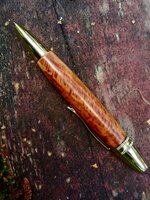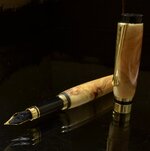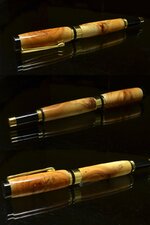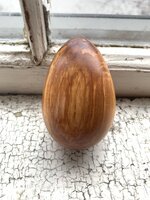You are using an out of date browser. It may not display this or other websites correctly.
You should upgrade or use an alternative browser.
You should upgrade or use an alternative browser.
I mostly turn my pens from willow grown in my garden
- Thread starter Brage
- Start date
Signed-In Members Don't See This Ad
See more from Brage
Signed-In Members Don't See This Ad
mark james
IAP Collection, Curator
That is a very attractive pen Brage. Well done.
Several years ago IAP acquired a large quantity of pen blanks from an estate. I have slowly been selling them off as a fund raiser for IAP. Of the 4,000-5,000 blanks, there were over 100 different species. Only a handful were marked as being "willow."
While it is a common tree in the USA, we don't see it as a turning material very often.
Best regards, Mark
Several years ago IAP acquired a large quantity of pen blanks from an estate. I have slowly been selling them off as a fund raiser for IAP. Of the 4,000-5,000 blanks, there were over 100 different species. Only a handful were marked as being "willow."
Estate Blanks Fundraiser
A couple months ago, I was contacted by an estate sales broker who was liquidating the estate of a penturner in Columbus, OH. (As far as we can tell, the man was not an IAP member.) I asked Mark James and Mike Broberg to join me to evaluate the potential purchase of the blanks, kits, and...
www.penturners.org
While it is a common tree in the USA, we don't see it as a turning material very often.
Best regards, Mark
southernclay
Member
Looks good! I turned about 10 pens for a guy out of a chunk of willow from their family farm. It was a little soft and not too easy to finish. An occasional knot would pop in though and made for some very pretty pens with a nice story for the family.
MRDucks2
Member
Nice grain. Like it.
1080Wayne
Member
I quite often turn willow for larger pieces , but haven`t done a pen for years . The colour absorption pattern intrigues me . If I`m reading the photo correctly , you used a straight grain piece of wood , yet the dye pattern is diagonal . Did you mechanically abrade the wood to achieve that , or is it just natural variation within it ? I have never dyed willow .
Willow can have very attractive spalt colour variation as well . Some have sapwood/heartwood boundaries that are sharp in colour change , hardness , and rot resistance , all in the same piece . Translated , that means soft , white , easily rotted sapwood , and fairly hard , red . very rot resistant heartwood .
A figure I sometimes see is the presence of birds-eye structures , but smaller than you might find in birds-eye maple . They might take the dye in an interesting way . Unfortunately , I can`t give you any guidance on what to look for on the tree to find them . If you know , please tell me .
The last feature we commonly see is what we call diamond willow . It is apparently caused by a fungal infection of of a developing branch , which kills the branch , causing the tree to develop a diamond pattern in the heartwood around it , leaving that portion of the heartwood essentially unprotected by bark . It is most common in Bebb`s willow , which is an upright growing , upland species - that is , it doesn`t tolerate wet feet . It was commonly used by the pioneers here (some Norwegian) for fence posts . However , pussy willow also occasionally develops diamonds in our conditions . It is a larger tree , likes damp feet but won`t tolerate flooding for more than 2-3 weeks , doesn`t mind growing a trunk at 30-45 degrees from vertical , nice spalt patterns , not very rot resistant heartwood .
Please don`t ask me to describe the salient features of the other 40 willow species native to Alberta . I can`t !
Willow can have very attractive spalt colour variation as well . Some have sapwood/heartwood boundaries that are sharp in colour change , hardness , and rot resistance , all in the same piece . Translated , that means soft , white , easily rotted sapwood , and fairly hard , red . very rot resistant heartwood .
A figure I sometimes see is the presence of birds-eye structures , but smaller than you might find in birds-eye maple . They might take the dye in an interesting way . Unfortunately , I can`t give you any guidance on what to look for on the tree to find them . If you know , please tell me .
The last feature we commonly see is what we call diamond willow . It is apparently caused by a fungal infection of of a developing branch , which kills the branch , causing the tree to develop a diamond pattern in the heartwood around it , leaving that portion of the heartwood essentially unprotected by bark . It is most common in Bebb`s willow , which is an upright growing , upland species - that is , it doesn`t tolerate wet feet . It was commonly used by the pioneers here (some Norwegian) for fence posts . However , pussy willow also occasionally develops diamonds in our conditions . It is a larger tree , likes damp feet but won`t tolerate flooding for more than 2-3 weeks , doesn`t mind growing a trunk at 30-45 degrees from vertical , nice spalt patterns , not very rot resistant heartwood .
Please don`t ask me to describe the salient features of the other 40 willow species native to Alberta . I can`t !
I think I cut the blank from a trunk area with a branch (crotch wood). I often do.The colour absorption pattern intrigues me . If I`m reading the photo correctly , you used a straight grain piece of wood , yet the dye pattern is diagonal . Did you mechanically abrade the wood to achieve that , or is it just natural variation within it ? I have never dyed willow .
JonathanF1968
Member
This is interesting, I am just beginning to experiment with willow. I have a willow tree in my yard that suffered some damage, a couple years ago, and I've got a few logs from it. It is a very interesting wood to turn. Much softer than what I'm used to, and fragile, but it is sanding out nicely. It certainly doesn't like my gauges very much. The skew gets a pretty decent result, but I'm sanding more than usual. Can I ask what your process is? Including how you are dying it.
Last edited:
I very seldom use dye now. If I do, I first wet with colorless alcohol and then immediately apply a spirit dye in one application. In pen turning, I only use the skew (sharp!). I sand with 180, 240 and 400 grit. To the 400 paper, I add some BLO, then sand a little, then add thin CA and continue sanding. Actually, I use BLO/CA as a sanding sealer. When this has dried, I apply medium CA (without BLO) in two or three layers. When this has dried, I sand with 1200 grit before polishing with an acrylic polish. This polish completely smooths away the 1200 grit sand marks and leaves a clear, shiny surface, so micromeshing before the polishing is not necessary. The pen in the photos is not dyed.This is interesting, I am just beginning to experiment with willow. I have a willow tree in my yard that suffered some damage, a couple years ago, and I've got a few logs from it. It is a very interesting wood to turn. Much softer than what I'm used to, and fragile, but it is sanding out nicely. It certainly doesn't like my gauges very much. The skew gets a pretty decent result, but I'm sanding more than usual. Can I ask what your process is? Including how you are dying it.
Attachments
JonathanF1968
Member
Thanks for that. Here's a willow egg I just turned. Just a bit of Penturner's Plus on it (it took quite a few coats) and some microcrystaline wax. I actually just use the skew for pens as well (once I've got a cylinder), but was shaping this egg with a small gauge that was leaving more marks than usual, even though it was reasonably sharp. My next one will be better. The colors and patterns are really crazy on the willow, though. I like it a lot more than I thought I would.
Attachments
JonathanF1968
Member
And your pens are lovely. The grain looks almost like plumes of smoke.




